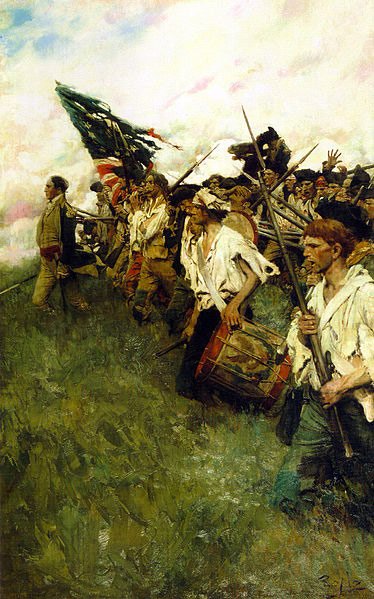Brandywine: The Battle that lost Philadelphia and built an army
Among the many historical events memorialized on September 11 is the Battle of Brandywine in 1777, a defeat for the Continental forces, but a significant turning point in the development of a capable United States Army. After victories at Boston, and defeat trying to defend New York City from British invasion, George Washington's army had shrunk to around 5000 men. After the morale boost of the Trention and Princeton campaigns at the end of 1776, in the midst of trying to rebuild, Washington maneuvered against British forces trying to capture Philadelphia in 1777. At first the armies skirmished in New Jersey, then, the British sailed to Chesapeake Bay on over 200 ships, attacking northward from Maryland.
Historians have given limited attention to this battle, and it is mentioned only in passing in history text books. A detailed presentation of the campaign is provided in Michael C. Harris's Brandywine: A Military History of the Battle that Lost Philadelphia but Saved America. Readers will find Brandwine Battlefield Park, Pennsylvania Trail of History Guide, to be a shorter summary of the battle, but still informative, or this later edition.
"While Howe had defeated the American army, the unexpectedly bitter resistance he met had kept him from his goal of crushing it. Nor had American morale been crushed. As Washington’s report to Congress stated, 'Notwithstanding the misfortune of the day, I am happy to find the troops in good spirits; and I hope another time we shall compensate for the losses now sustained'," (John B.B. Trussell, Jr., The Battle of Brandywine, 1992). The British did occupy Philadelphia, serving at that time as the national capital, and held it until June 1778. Congress had to move to York, Pennsylvania. But, possession of the city proved, as John Adams had predicted, to be a millstone around the enemy's neck.
.
Less than two months later, the Battle of Saratoga, in upstate New York concluded with the first surrender of an entire British Army to Continental troops.
The 1st Rhode Island regiment -- which contained several companies filled entirely by men of African descent, was a reliable component of the shrunken army -- many "white" soldiers went home after short enlistements, but enslaved men freed in recognition of enlistment were among the first who were committed for the duration of the war. Benoni Bates, from Newport, survived the war and lived in Cranston, Rhode Island until 23 January 1838, eventually receiving an $8 monthly pension.
Caesar Shelton and Caesar Clark, both of whom served in the 4th Connecticut regiment, are both well documented. Caesar Shelton was born while his mother was being transported from Africa. John Shelton of Stratford held title to him as a slave at the beginning of the war. He first enlisted in 1776 as a substitute for Shelton's son, then re-enlisted on his own in 1777 for three years. He was listed in the 1790 and 1800 census, married, in Weston.
Clark enlisted at Ashford Connecticut in 1777, when the regiment was being reorganized with longer terms of enlistement, often for the duration of the war. He later applied for a revolutionary war pension and bounty land in Montville, Connecticut and married Judith Shelton in 1789. (Its not clear if she was Caesar Shelton's sister). In 1780, three years after Brandywine, the 4th Regiment's 2nd Company was made up of forty-eight privates and non-commissioned officers, posssibly the most ethnically homogenous unit after Rhode Island's 1st Regiment.
Edward Hector, a man of African heritage serving in the Third Pennsylvania Artillery, offers one of the more heroic stories of the battle. He was positioned on a wooded hillside near Chad's Ford, one of the points where Brandywine Creek could be crossed by an army.
When the British army crossed farther up the creek, circling to the rear of the American army, orders were given to abandon equipment and retreat. Hector insisted on saving his horses and ammunition wagon, also gathering up several stands of guns abandoned on the field. After the war, some of his neighbors in Norristown appealed for him to be granted an army pension, but it was refused until he was near death in 1834. His only payment was $40.
Shadrach Battles first enlisted in 1777 and served two eighteen month tours of duty in the 10th Virginia Regiment, commanded by Captain Franklin in the brigade of General George Weedon. Near the end of the battle, this regiment formed the rear guard fighting off advancing British soldiers to allow the rest of the army time to retreat. Battles was born free in 1746, and his family moved in 1752 to Louisa County, where his father purchased 191 acres of land. He also fought in the battles of Germantown, Monmouth, and Stony Point, and spent the winter of 1777-1778 at Valley Forge.
John Banks, from Goochland County, VA, fought at Brandywine as part of 2 years service in Theodore Bland's cavalry regiment. As with many Continental army units, it appears that his dark complexion was no obstacle to serving in the cavalry.
Henry Hill's service at Brandwine, as well as Lexington, Monmouth, Princeton and the final British surrender at Yorktown, is known only from his obituary in the Chilicothe, Ohio Advertiser. He died 12 August 1833, and was buried with the honors of war, reckoned by William Cooper Nell as "a singular tribute of respect to the memory of a colored man" when Nell wrote The Colored Patriots of the American Revolution in 1855. Having served at Lexington, Hill most likely was born and initially enlisted in Massachusetts.


